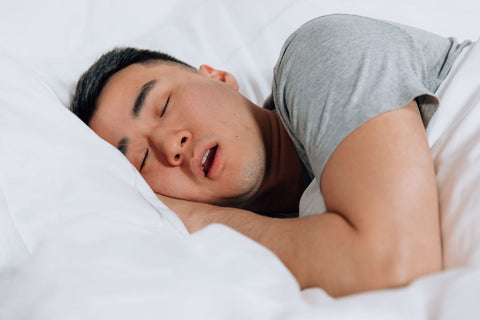You may think your nose is just a facial feature that provides a sense of smell. In reality, the nose is your first line of defense against viruses and bacteria in the air.
However, this defense only works if you breathe through your nose instead of your mouth.
Although nasal breathing is the method of breathing we were designed to use, between 30 and 50 percent of adults are still habitual mouth breathers.

This causes harmful symptoms during both sleeping and waking hours, such as poor sleep and poor oral health. On the flip side, there are many advantages toi keeping your mouth shut both day and night.
That’s why you have to learn how to keep your mouth shut when sleeping, as well as during waking hours.
The Advantages of Keeping Your Mouth Shut
Chances are, you breathe through your mouth without realizing it.
Despite the fact that mouth breathing typically develops as an unconscious habit, certain conditions may increase your risk of being a mouth breather.
These conditions include chronic allergies, asthma, sinus infections, hay fever, and chronic anxiety and stress, to name a few.
Over time, mouth breathing leads to:
- Dry mouth
- Bad breath
- Increased risk of cavities and gum disease
- Snoring
- Sleep apnea
- Sore throat/hoarseness
- Fatigue
- Irritability
- Brain fog
Your nose, on the other hand, was specifically designed to help you breathe efficiently and deliver oxygen to your lungs. This leads to improved sleep at night and boosted concentration during the day.
The benefits associated with nasal breathing over mouth breathing are largely connected to the nose’s production of nitric oxide.

In 1995, Swedish researchers discovered that the nose produces nitric oxide within the paranasal sinuses, aiding in circulation, homeostasis, immune function, respiration, and more.
The nasal cavity also:
- Humidifies and warms the air
- Filters foreign substances, pathogens, and germs
- Increases oxygenation to vital organs
- Improves lung capacity
- Lowers the risk of allergies and hay fever, which worsen the chances of mouth breathing
- Decreases the risk of snoring and sleep apnea
- Supports healthy oral health
On your journey toward understanding how to keep your mouth shut when sleeping (and during the day), it’s important to first examine your unconscious breathing patterns.
Examine Your Breathing Patterns
The beginning step to learning how to keep your mouth shut while breathing? Bring your awareness to your daily breathing patterns.
For example, do you experience any of the following breathing challenges?
- Gasping for air upon waking
- Dry mouth/congestion in the morning
- Your mouth often drops open during the day
- You experienced blocked nostrils frequently
These are all common signs that you have an issue with mouth breathing, either at night, during the day, or both.

The only way to begin breathing in and out of your nose over your mouth is to put nasal breathing into practice.
Mouth breathing is a cycle that’s tough to break. The more you habitually use the mouth to breathe, the worse congestion becomes, leading to more mouth breathing.
Nasal breathing helps break that cycle – but you have to decongest initially.
Decongest/Treat Allergies and Illness
Chronic congestion is the fastest path to chronic nasal congestion and mouth breathing. That’s why it’s so important to treat allergies and illnesses as they arise.
You can decongest in a quick pinch with the help of nose-clearing breathing exercises.
To perform these, breathe regularly for a few minutes. Then, close your mouth and inhale through the nose. Pinch your nose with your fingers, moving your head up and down.

When you feel a large hunger for air, release your nose and exhale through it, beginning to breathe normally through your nose. Repeat this as needed until you clear your nose.
Over-the-counter nasal decongestant sprays may also help to keep your nostrils free from obstruction. Clear your nose by blowing it, then place the nozzle into your nostril and spray the solution into your nose.
To keep your nose free and clear as you sleep, work on changing your sleeping position to promote nasal breathing.
Change Your Sleeping Position
As we’ve discussed, most people who mouth breathe during the day and/or night find that nasal congestion is a huge contributing factor.
Although decongesting with breathing exercises and nasal sprays helps to remedy this issue, your sleeping position can, too.
Sleeping with your head in an elevated position can help you prevent the tissues in your airway from falling backward, as well as your mouth from falling open.
Sleeping on your back may also increase the chance of mouth breathing, while sleeping on your side minimizes the chance of snoring and open mouth breathing.

Moreover, the pillow you choose may affect your breathing. Get a pillow or wedge that keeps your head up at at least a 30-degree angle, which promotes breathing through the nose.
In severe cases of congestion and mouth breathing, professional intervention may be necessary.
Seek Myofunctional Therapy
In severe cases of congestion, a deviated nasal septum may be to blame. This requires professional treatment (and may also require surgical intervention).
Myofunctional therapy may also benefit your breathing methods. If you’ve been a habitual mouth breather for most of your life, myofunctional therapists help you retrain the muscles in and around your face and airway.
This training helps you utilize your airway in a way that benefits the way you breathe. For example, trained myofunctional therapists can help you develop a proper tongue posture that makes nasal breathing more achievable and comfortable.
Myofunctional therapists can also offer tools that help you learn how to keep your mouth shut when sleeping, like nasal and mouth strips.
Tape Your Nose and Mouth
Once you’ve trained your breathing and can maintain nasal breathing during the day, you may still face challenges learning how to keep your mouth shut when sleeping.
Nasal strips help you to keep the nostrils dilated as you sleep. Over-the-counter options, like Breathe Right nasal strips, work by adhering to the external skin on the nostrils.

The strips, which are made of rigid plastic material, pull the nostrils open, preventing them from collapsing in on themselves.
Internal nasal dilators work in a similar manner, pushing the nostrils open from the inside.
However, there is just one problem with nasal strips and internal dilators: they don’t keep your mouth from falling open.
That’s where mouth tape picks up the slack.
@somnifix #DidYouKnow mouth tape can improve your #sleep quality? #yoga #decompress #relax #breathwork #wellness 😴 Use “MAYSYOGA” on your next #somnifix ♬ Blade Runner 2049 - Synthwave Goose
Although nasal breathing may become habitual during the day, mouth tape is the only way to ensure that you can nasal breathe while you catch some much-needed Zzz’s.
As a bonus, you’ll sleep better than ever due to the added benefit of unfragmented sleep that mouth taping provides.
Sleep Soundly With SomniFix
When learning how to keep your mouth shut when sleeping, SomniFix Mouth Strips are your best friend.
They’re hypoallergenic, skin-safe, and so comfortable that you’ll forget you’re wearing them at all.

As a result, you’ll nasal breathe into the night without a second thought.
That means that all of the health benefits associated with nasal breathing like boosted immunity and decreased snoring become a reality (without any added effort).
Try SomniFix tonight for improved breathing, better sleep quality, and better health!



